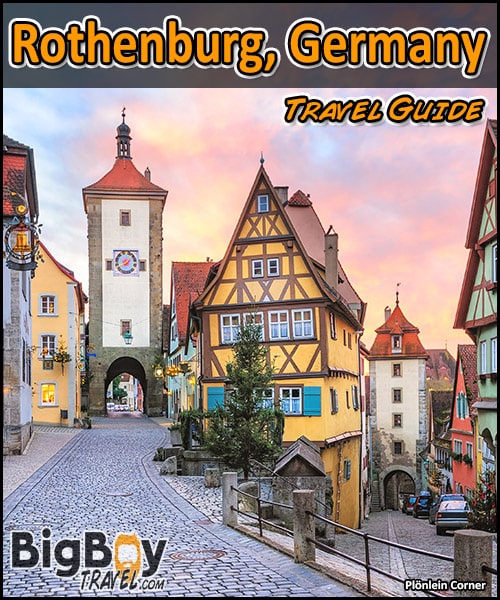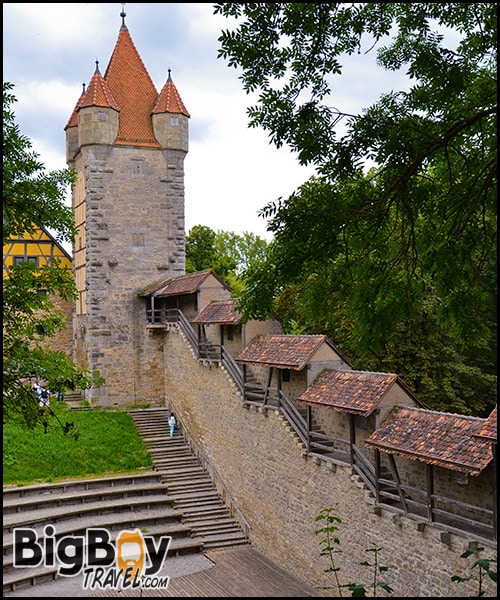Rothenburg ob der Tauber, Germany:
Settled In: 960 AD (Castles in 1080 & 1142)
Officially Founded: Free Imperial City in 1274 AD
Language: German, but basic English gets you by.
Suggested Stay: 2-3 Full Days with overnight stay
Sitting above a fertile river valley, the village of Rothenburg ob der Tauber is a well-preserved medieval wonderland. Almost unchanged since the 1600s, the half-timber homes with brightly colored facades, narrow alleys, and intact city walls make Rothenburg one of Europe’s must-see villages.
The name Rothenburg ob der Tauber means “Red Castle on the Tauber River” due to the castle built here in the 1100s by the King of Germany, Conrad III, which adds to the lore. You’ll love attending the festivals, visiting the Christmas market, joining the Night Watchman on his duties, eating authentic Franconia food, and touring the Medieval Crime Museum. We hope you enjoy our ultimate Rothenburg Germany travel guide which covers suggested itineraries and all of the best stuff to do!
Top Things To Do In Rothenburg:
2. Old Town Walking Tour
Read More: Top 10 Things To Do In Rothenburg
Historical Overview Of Rothenburg ob der Tauber:
Due to fires in the town halls of Rothenburg ob der Tauber in the Middle Ages, many historical records were lost, but the pieces of early history preserved today are still very fascinating. This general area of the Tauber River Valley was first settled by Celtic people over 2,000 years ago. There are sections of both the original preserved and recreated Celtic Wall (Keltenwall) that can be found along the western banks of the Tauber River. Little is known about this early era, however, archeologists recently found a folding chair from the Dark Ages in a grave on the outskirts of Rothenburg which dates back to 600 AD. These discoveries show us there are so many secrets left to uncover in the early history of Rothenburg ob der Tauber.
The recorded history of greater Rothenburg starts around 960 AD, when the hamlet of Detwang was established in the lower valley along the river. The church there was consecrated by the Bishop of Worms in 968 AD and still has an old-world feel. Although it sits high above the Tauber River, some of the buildings inside the boundary of Rothenburg’s old town have foundations that also date back to the 900s, including that of Zur Holl Restaurant, which is the oldest in town.
Rothenburg proper grew more formal roots around 1070-1080 AD when the Counts of Comburg built a wooden fortification above the river called the Vinegar Jug along today’s Spital Quarter. The Counts of Comburg were headquartered out of Schwabish Hall and controlled vast areas of land, including this stretch of the Tauber River Valley.
It is assumed that the early hilltop settlement in Rothenburg was only sparsely populated, but it did attract in Conrad III Hohenstaufen whose uncle Henry V was the Holy Roman Emperor. Part of the reason Conrad III was drawn in was to marry Gertrude in 1115, who was the daughter of the last Count of Comburg; the following year, Conrad III was named the Duke of Franconia by his uncle.
With an embattled rise to power and powerful allies, Conrad III became the King of Germany in 1138. This was followed by King Conrad III building his royal castle in Rothenburg in 1142. The Hohenstaufens’s red castle (Rothenburg) gave the village its name and a lot of power as it officially started to form around 1170.
King Conrad died before he could be crowned Holy Roman Emperor, and after his son (Friedrich IV) also died, the castle sat vacant, but the village around it grew. Gaining a ton of power with its location at the crossroads of two important trade routes, Rothenburg was further elevated to a Free Imperial City in 1274 by King Rudolf of the Habsburg Dynasty. The trade routes were the Thuringian Castle Road (also called middle Saint James Way) going East to West from Prague to Paris and the Romantic Road (Known then as the Staufen Road) running North and South.
With its newfound status, the city became one of the most important city-states of the Middle Ages. Although the castle fell into disrepair, this stone helped create a powerful city wall to protect the prospering village. By 1400, Rothenburg grew to be one of the ten largest towns in the Holy Roman Empire, with 6,000 residents, and the second largest in Germany behind Cologne.
Jewish people were kicked out of town by the Council after pressure from preacher Johann Teuschlein. Rothenburg participates in the Peasants’ War and tries to introduce the Reformation, but Margrave Casimir has to surrender. Johann Teuschlein and other rebels are executed. Reformation hit Rothenburg in 1544 turning it Protestant. Churches were forced to change by 1559, with only the Knights of St. John (until 1809) and the Teutonic Order (1672 bought by the city) remaining Catholic, but both orders of knights had to renounce their churches, Saint Jakob and Saint Johannis.
During the 30 Years’ War in 1631, the Catholic Count of Tilly forcibly desecended onto Lutheran Rothenburg to quarter his 40,000 troops. Tilly had been on the way to another city, but bad storms forced him to go to Rothenburg instead. Legend has it that Count Tilly told the villagers that if anyone could drink a 3-liter tankard of wine in one drink he would take his troops and leave. Mayor Nusch took the challenge and saved the town by drinking it all in a single gulp, which today is celebrated as the so-called “Master Draught”. In reality, the troops stayed through the Winter and left the city poor and depleted. In total, Rothenburg is occupied seven times during the war. The major regional trade routes changed after the 30 Years’ War, and Rothenburg never recovered. The most devesting occupations were in 1631 & 1634 by the Swedes plus 1645 by the French. Because of its lack of income, Rothenburg was frozen in time and persevered from modernization.
Shortly after Rothenburg was annexed into Bavaria in 1802, tourists started arriving at the picture-perfect village. By 1880 preservation laws were quickly passed to prevent the city from modernizing. The Medieval time capsule attracted artists and tourists from all over Europe. It was the beauty of the city that ultimately saved it from being completely destroyed by American artillery in WW2. There was heavy damage from aircraft bombing, but thankfully it has been repaired through donations. Today Rothenburg ob der Tauber is one of the most magical places on allowing you to step back in time.







